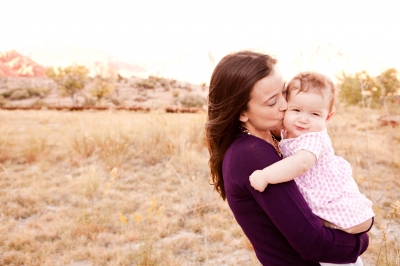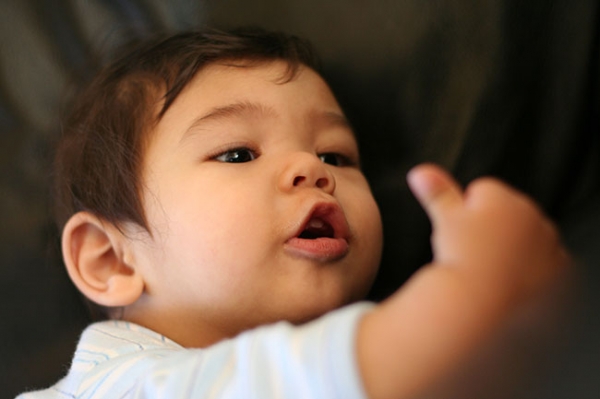The Most Fun Baby Signs
by Brittany FerrellSigns for Hobbies and Feelings
4. Signs for Hobbies/Interests -
The sign for “play” is like making the “hang loose” sign with both hands (extending out your pinkies and thumbs while keeping the rest of your fingers together). This is a fun sign for people of any age to act out, but you can couple this sign with other signs that reflect your child’s interests. For example, you could pair “play” with “ball” (palms facing one another, fingers extended like you are holding a grapefruit, then moving your hands together and apart) to ask if your child wants to play with the ball.
You can tailor your sign language acquisition to include the particular objects and activities that your child is interested in.
You might want to learn the words for car, truck, and motorcycle or the words for musical instruments, depending on the child. Of course, if your child is like mine, you will soon develop an immense sign vocabulary as his/her interests and fascinations change daily!
5. Signs for Feelings -
One of the most important aspect of communication is the ability to convey our feelings and emotions to another. Our little ones are bundles of emotions, both positive and negative. It usually pretty obvious when your child is happy because he/she will squeal in delight and clap their hands and it is even more apparent when your child is unhappy because you will hear about it at the top of their lungs. Conversations about how and why our children feel the way they do can begin right now through sign language.
To make the sign for “happy”, act like you are brushing your hands in circles up your chest a few times. When making this sign, it helps to smile broadly to emphasize the feeling. You can begin asking your child if they are happy and what makes them happy. My daughter loves to let me know how happy it makes her to pet our dog…or any other dog for that matter. I knew from the expression on her face that she loved petting dogs, but showing her how to share the inner workings of her young mind has set the stage for, what I hope will be, a lifetime of open communication.
##adbig##
I validate her feelings by making the sign back to her and then pepper her with questions like, “Do you like the dog’s soft fur?” “Do you love to snuggle with your dog?” “Were those kisses wet?” I am trying to teach her to think about her feelings while also attempting to expand her vocabulary with words like soft and wet.
Similarly, it is important to get your child in the habit of explaining why they are upset when they start melting down, so that you may problem solve together. The sign for “frustrated” is making by taking one hand to the opposite cheek like you are saying, “I have had it up to here!” The sign for “sad” is made by running your fingers down your face like imaginary tears are falling.
My goal is to teach my daughter to differentiate between these emotions, so that she can find the appropriate solution. For example, she is most likely sad that our dog no longer wants to play fetch with her, but frustrated when she cannot get the lid off the container of Legos. In the first instance, I can show her how to find another activity where she can play without our dog (who most likely needs a toddler break!) and the second instance, I can ask if she needs help to accomplish her task. (The sign for help is made by making the “thumbs up” sign with one hand and placing that hand in the palm of the other.) Again, I want to validate my daughter’s feelings, but I also want her to express her feelings in an appropriate way and begin developing problem solving strategies.
One of the best signs for feelings, or any sign for that matter, is the sign for “I love you”. To make this sign, put your thumb, index, and pinkie finger up and your ring and middle fingers down. Then, wave your hand back and forth. The day my daughter just looked up at me with her big, brown eyes and made the “I love you” sign followed by a giant hug around the legs, brought me to tears.
As you are learning sign language along with your child, remember that it is okay to make modifications to best suit your needs. Once you have introduced a sign, keep practicing it consistently, even after your child has mastered it. Add to your sign language vocabulary based on the needs of you and your child. Most importantly, have fun!

Brittany Ferrell, Psikoloji alan?nda lisans derecesine ve E?itim alan?nda yüksek lisans derecesine sahiptir. On iki y?l boyunca ilkokul ö?retmeni olarak çal??t? ve 2011 y?l?nda "Y?l?n Ö?retmeni" ödülüne lay?k görüldü. ?ubat 2014'te Brittany ve harika kocas? Jerome, mucizeleri Madeline Olivia'y? dünyaya kar??lad?lar ve o, ö?retmen olmak için verdi?i mücadeleyi anlatt?. "Rüyadan Hayale Gerçe?e: Anneli?e Yolculu?um" adl? yay?nlanm?? an? kitab?nda bir ebeveyn . Brittany , A Mama Tale adl? blogunda annelikle ilgili masals? hayalinin gerçe?e dönü?tü?ünü yaz?yor . Deneme Bonusu












